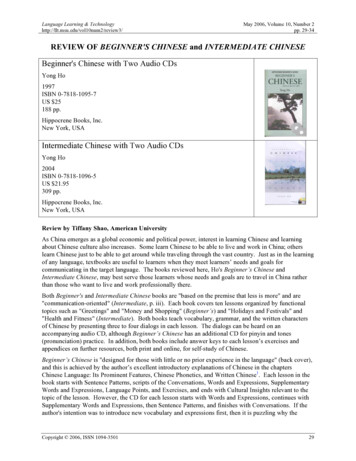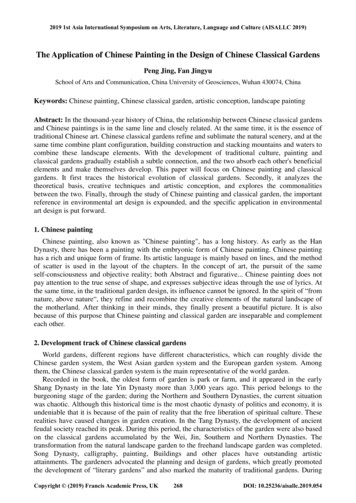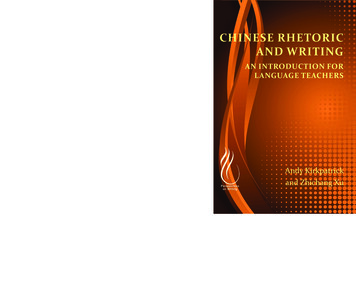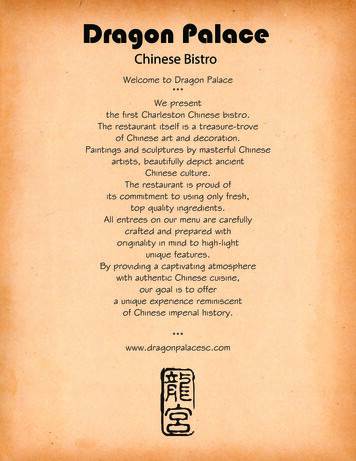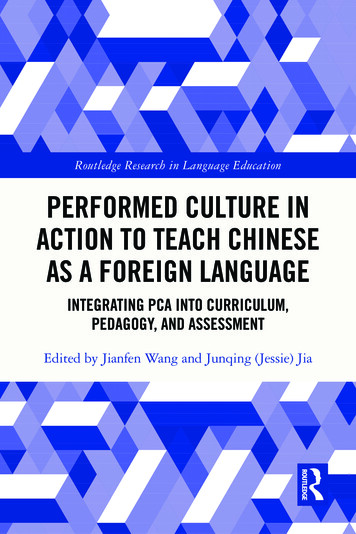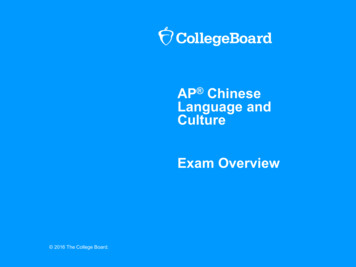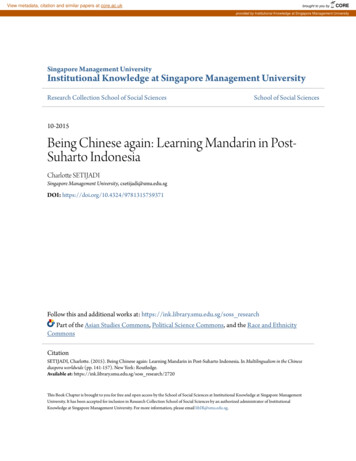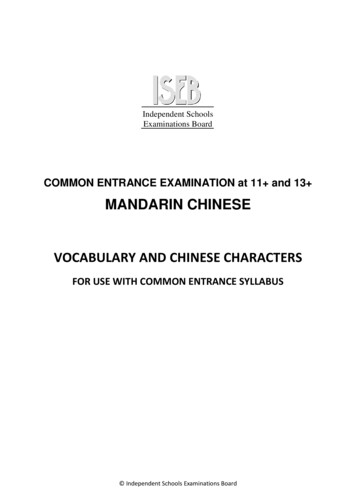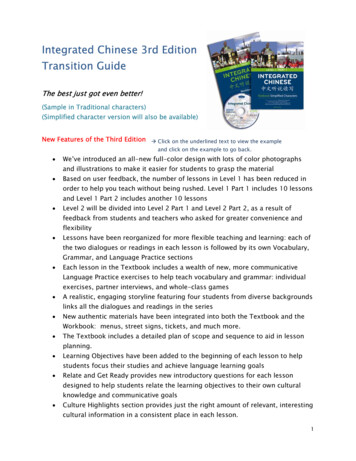
Transcription
Paper Code WAN06122Understanding Chinese Culture and LearningTing WangUniversity of Canberra, AustraliaAbstract: This paper examines Chinese learning traditions and research on Chinese learners’conceptions of learning. It begins with the analysis of Chinese culture and its influence onlearning and teaching traditions. Some commonly held opinions and recent interpretations ofChinese learning and teaching are also presented. The influence of the basic tenets ofConfucian conceptions has been pervasive over the centuries and can still be felt incontemporary Chinese education. It is a complex tradition which embraces various goals forlearning, but it has been reduced to a simple stereotype by some Western observers, forinstance, rote learning and examination culture; authoritarian teacher and obedient student;and transmissive teaching and passive learning. Recent years have seen somereinterpretations and new understandings of Chinese learning and teaching: “Confucianconfusions”, memorising and understanding; a family relationship between student andteacher; a mixture of authoritarianism and student-centredness; and “Chinese learner”paradox. This paper argues that Chinese learning and teaching are more subtle and complexthan they appear to be in some representations of them. Relevant studies also provideevidence that conceptions of learning, teaching and knowing are deeply rooted in specificcultural antecedents and social structures.Key words: Chinese culture, Chinese learners, learning and teachingChinese Learning in Confucian TraditionWe are what we are because of culturally based learning (Segall et al., 1990).In any social system, culture serves as a perceptual framework that guides the interpretationof interactions and the construction of meanings (Cortazzi, 1990). In educational institutions,this can include perceptions regarding rights, rules, roles and unspoken assumptions abouthow to learn and what is worth learning (Barker, 1997; Cortazzi & Jin, 1997; Hofstede, 1986).Hence, an investigation of the Chinese culture and learning traditions provides an appropriatebackdrop to understanding Chinese learners’ conceptions of learning.Chinese education and learning traditions have been influenced by Chinese culture in generaland Confucianism in particular for centuries. Within many schools of thought in Chinesetraditional culture, Confucianism has been the most important influence. The great teacherphilosopher, Confucius’ (551 BC) notion of education as changing people for the betterremains at the heart of the purpose of education even in the early years of the thirdmillennium (Bush & Qiang, 2000; Wong, 2001). The development and characteristics of thesystem of Chinese education have been greatly influenced by Confucianism and this1
traditional culture (Wang & Mao, 1996). Cleverley (1991) argues that traditionally theChinese have placed a high value on education. While modern schooling has beenaccompanied by far reaching attitudinal change, “the Chinese people have not lightlydiscarded the patterns of thinking and action from their rich historical past whose values havepermeated the new Marxist precepts” (Cleverley, 1991, p. xii).Some scholars believe that all education in mainland China is based on Confucian principleseven though the teachers and students are often unaware of the source (Jin & Cortazzi, 1998).These principles include the high value placed on education by society; beliefs that learninginvolves reflection and application; that hard work can compensate for lack of ability; that theteacher is a model both of knowledge and morality; and that learning is a moral duty andstudying hard is a responsibility to the family (Watkins, 2000; Watkins & Biggs, 2001). Lee(1996) argues that contemporary explanations of the cultural contexts of Chinese learnershighlight a number of Confucian conceptions which continue to have currency.The significance of educationThe significance of education features highly in the Confucian tradition. Education isperceived as important not only for personal improvement but also for societal development.The Great Learning constitutes one of the Four Books, and the opening sentence ofConfucius’s Analects (I.1) refers to the significance and joy of learning: “Is it not pleasant tolearn with a constant perseverance and application?” (Analects, 1990) Education is not onlyimportant for personal development, according to Confucius, society requires learned peopleto be officials: “The officer, having discharged all his duties, should devote his leisure tolearning. The student, having completed his learning, should apply himself to be officer”(Analects, XIX. 13), a similar notion to Plato’s philosopher king, who asserts that the countryshould be ruled by wise and learned people (Lee, 1996, pp. 26-27). This conception hasinfluenced the traditions of bureaucracy and officialdom, and it has carried implications forconcepts of learning and leadership in contemporary China.Educability for all and perfectibility for allThe high status of education in the Confucian tradition rests upon the presumption thateveryone is educable. Confucius himself set an example by never refusing to teach whosoevercame with a nominal ceremonial tutorial fee (Analects, VII. 7). One of his most famoussayings refers to education without class distinction (Zhu, 1992). Confucius was aware ofsocial inequality, “By nature men are nearly alike, but through experience they grow wideapart” (Analects, XVII. 2). However, his practice was to use education to overcome sociallygenerated differences. The concept that everyone is educable, everyone can become a sage,and everyone is perfectible forms the basic optimism and dynamism towards education in theConfucian tradition. And this explains why education is viewed to be wholly significant insuch a tradition (Lee, 1996, pp. 28-30).Learning, effort, will power, and human perfectibilityThe concept of the attainability of human perfectibility is expressed in terms of sagehood inthe Confucian tradition, and is closely related to education. To the Confucianist, educationand learning are always associated with effort. Self-determination or will-power is the drivingforce of efforts. “If another man succeeds by one effort, he will use a thousand efforts. Ifanother man succeeds by ten efforts, he will use a thousand. Let a man proceed in this way,and, though dull, he will surely become intelligent; though weak, he will surely becomestrong” (The Mean, XX. 20-21). It is clear that human perfectibility, learning, rationality,effort, and will power are discussed in the Confucian tradition in close relationship. They are2
so closely interrelated that they are sometimes inseparable. This Confucian traditionilluminates how Chinese learners view education, and explains why effort is seen to be soimportant in the process of human perfectibility (Lee, 1996, p. 32).Intrinsic motivation of learning: learning for self-realizationThe notion of “learning for the sake of one’s self” best signifies the individualistic orientationin education in Confucian tradition. Learning is considered to be an end in itself rather than ameans to an end (Tu, 1985). It originates from Confucius’ dictum in the Analects (XIV. 25),which was expanded to criticize the attitude of learning for the sake of pleasing others orshowing off to others. This notion was seized upon by the Neo-Confucianists in the SongDynasty (960-1279) who attacked bureaucratic scholarship and the vogue of learning forsitting civil examinations. Tu (1985, pp. 55-57) interprets “learning for the sake of the self” tomean self-cultivation. The purpose of learning is therefore to cultivate oneself as an intelligent,creative, independent, autonomous, and authentic being. The process of learning is thereforean inner-directed process. This ideal of learning is similar to Maslow’s (1968) concept of thepeak experience of learning, ultimately oriented towards self-actualization (Lee, 1996, p. 34).The deep approach to learning: promoting reflection and enquiryConfucian traditions of learning and teaching also emphasise deep as opposed to superficialknowledge. As education in the Confucian tradition is considered important for its intrinsicvalue, it is by nature inclined towards the deep approach rather than the surface approach tolearning. There is strong stress on the significance of reflective thinking in the process oflearning in the Confucian tradition. Apart from suggesting that seeking knowledge (learning)and thinking are two sides of the coin, Confucius’ conception of learning was indeed aprocess of “studying extensively, enquiring carefully, pondering thoroughly, sifting clearly,and practicing earnestly” (The Mean, XX.19). The emphasis on reflective thinking in learningrequires a spirit of enquiry and open-mindedness. It is worth mentioning that memorization isseen as a significant part of learning in the Confucian tradition, but should by no means beequated with rote learning. Memorization precedes understanding, and is for deeperunderstanding. It has never been regarded as an end in itself. Memorizing, understanding,reflecting and questioning are the basic components of learning. They are interrelated andintegrated, and should be repeated for future and deeper learning (Lee, 1996, pp. 35-36).Achievement motivation in learningConfucian tradition not only places emphasis on the intrinsic significance of education butalso on the dimension of external manifestation and utility of education. The fact that a personshould seek perfection (pursue sagehood) and a government office has thereby become anideal of the Confucian tradition, which is typified in the notion of “sage within and kingwithout” (Neisheng waiwang) (Chang, 1976, p. 293). It is said in The Great Learning that aperson1 should “cultivate himself, then regulate the family, then govern the state, and finallylead the world into peace” (The Great Learning, IV). This can be interpreted in two ways: if aperson wants to govern the state, he should first cultivate himself; on the other hand, if thereis a person who has cultivated himself sufficiently well, he should seek to influence the1A person here refers to a man or a woman. However, he is used afterwards, indicating a strongpatriarchal culture in ancient China.3
outside world. Hence for Confucius, a scholar should ultimately seek the opportunity toobtain a government office, in order to extend his good influence. Paradoxically, theaspiration for extrinsic rewards coexists with the ideal of external manifestation of a person’sinternal establishment in the Confucian tradition (Lee, 1996, pp. 37-38). The concepts oflearning are part of a political order, which also suggests a utilitarian end of learning and aquest for officialdom and self-cultivation.Some Commonly Held OpinionsThe influence of the basic tenets of Confucian conceptions of learning has been pervasiveover the centuries and can still be felt in contemporary Chinese education (Bush & Qiang,2000; Wong, 2001). It is a complex tradition which embraces various goals for learning, but ithas been reduced to a simple stereotype by some Western observers. The following accountsdescribe some commonly held opinions about learning and teaching in China.Rote learning and examination cultureThe Confucian tradition has influenced Chinese education for more than 2000 years. Someresearchers argue that the emphasis was on rote-learning for centuries and the whole processof learning was geared to the memorization of ideas of antiquity, by way of the Four Booksand Five Classics. This made up the content of education which had to be mastered for theCivil Service Examination. This national-run public examination for selecting governmentofficers, called Ke Ju, started in China more than 1000 years ago. If candidates could recitethe texts correctly during the Examination, they would obtain an official position in agovernment organisation. The examination tradition therefore promoted rote-learning as thepreeminent method of teaching and learning (Wang & Mao, 1996).Nine decades have passed since the Civil Service Examination was abolished in 1905, but themethod of memorization is still prevalent among Chinese learners. It is still thought thatpeople should memorize as much knowledge as possible and that one cannot produce orcreate until one has accumulated enough basic knowledge (Guo, 1996). Many commentatorson contemporary Chinese education suggest that learning for exams still relies heavily onmemorization. Such exams, they argue, promote surface learning—the ability merely torepeat information without a real understanding of meaning or of how the new informationrelates to previous knowledge (Kennedy, 2002). A strong focus on examinations has beenrecognized as a weakness of the basic education in China (Gao & Watkins, 2002). The examculture acts as a barrier to creative expression, critical thinking and problem-solving ineducation and subsequently in work. Chinese students are frequently characterized as hardworking and diligent but lacking in creativity and originality: for example, “even thoughChinese students do better than Western students in mathematics and sciences, they are notknown for their creativity and original thinking” (Salili, 1996, p. 100).The Civil Service Examination was viewed as an effective method of selecting “excellent”intellectuals. Every candidate had the opportunity to reach the top status in society andconsequently become rich if they could succeed in the Ke Ju. Schooling was considered a wayof educating government officials, the so called Xue Er You Ze Shi2 (Gao & Watkins, 2002).This phenomenon is reflected in the following idioms: “although studying anonymously for2This is a quotation of Zi Xia, one of the followers of Confucius. It means that when a scholar is able tocope beyond studies, he should take office in the government.4
ten years, once you are successful, you will become well-known in the world” and “there aregolden houses in books and there are beautiful girls in books” (see also Lee 1996).From the thirteenth century onwards, success in Civil Service Examinations could lead togreat wealth and high status (Lee, 1996, p. 37). Even today, in contemporary China, academicsuccess still remains the route to a good job and high social status. Schooling in China is oftenconsidered an important and effective way of raising one’s social and economic status.Success in public examinations, for instance, the National University Entrance Examination,means that one can expect a better career with security and high income after graduation fromuniversity. Parents are therefore very concerned about their children’s performance inexaminations. Most reward their children for higher marks in examinations or punish them forpoor performance. Student records in public examinations are treated as the most importantindicator of the quality of schools by the community (Gao & Watkins, 2002; Simon, 2000).Learning is therefore considered as utilitarian, and knowledge as useful information orobjective truth to be mastered by students. Students know their academic success, andeventual economic and social status, hinge upon achievement, which is linked toexaminations. This linkage from authorized knowledge, to testing, to achievement, andeventually to privilege, is apparent from elementary school through university in China (Prattet al., 1999). Kvale (1996) points out the cyclical nature of this relationship and problematisesthe nature of the examination process in China.Authoritarian teacher and obedient studentThere are generally two conceptions of teaching and learning (Cortazzi, 1990). Oneperception views them as hierarchical, positioning the teacher as all knowing and his/herknowledge as being transmitted directly to learners. Another perception views the relationshipbetween the teacher and students as more egalitarian. This latter perception views learners ascreatively building up knowledge and concepts through activity, participation andindependent thinking (McClure, 2003). The first perception has been often associated withAsian or high-context cultures, like Chinese culture, that stress “continuity, stability, andgroup identity” (Cortazzi, 1990, p. 58). The second is linked to Western or low-contextcultures that emphasise individual development, innovation and an egalitarian ambiance.Cortazzi (1990) stresses that both perceptions “are present in most of cultures but receive verydifferent emphasis, with the result that varied expectations come about, affectingpresuppositions about learning and teaching”. Cortazzi and Jin (1997) argue that Chineseacademic culture tends to put an emphasis on the first perception.This academic culture can be traced back to the Chinese traditions of respecting authority andrank. According to the Confucian code of social conduct, Wu Lun (five cardinal relationships),children are taught to have respect for age and rank—for parents, elders and ancestors (Bond,1996). Teachers were traditionally listed among the five categories of those most respected byChinese society: the God of Heaven, the God of the Earth, the emperor, parents and teachers(Zhou, 1988). Proper respect is to be given to teachers, whose wisdom and knowledge istaken for granted and not questioned (Cortazzi & Jin, 1997). Students are expected to “respectthe teacher’s authority without preconditions” (Wang & Mao, 1996, p. 148).Besides their extensive knowledge and intelligence, teachers were and are regarded by theirstudents as their “parents”, people who would look after them with care and love. There is asaying in Chinese about the relationship between students and teacher: “If someone taughtyou as a teacher for one day, you should respect him as your father for the rest of your life”(Wan, 2001). In turn, students are expected to obey their teachers just as they do their parents.A traditional feudal parent-child relationship is therefore reflected in the teacher-student5
relationship (Guo, 1996). Chinese learners have been brought up to respect wisdom,knowledge and expertise of parents and teachers. They have been socialized to respect thosewho provide the knowledge and to avoid challenging those in authority (Chan, 1999).It is frequently contended that socio-cultural attitudes such as emphasis on authority and facepromote conformity and reinforce passive, compliant roles in class (Kennedy, 2002). Theconcept of face (mian zi)―having status in front of others―is important. It is argued that it isChinese tradition that people are afraid of making mistakes, for losing face. This traditionaldoctrine, which advised people to take a neutral stance, is still observable in China today.Pratt (1992, p. 303) notes that Chinese proverbs, such as “the bird that stands out will be shotfirst” and “the taller tree will catch the wind first”, warn people not to take risks but “to play itsafe”. It is considered selfish and shameful to cause someone to “lose face” (Bond, 1996).Students are not encouraged to speak out, to question or to criticize, and are unwilling tocommit themselves for fear of being wrong and thus losing face (Tsui, 1996). Being modestand self-effacing, not “blowing your own trumpet” is praiseworthy, while wasting otherstudents’ class time by expressing independent judgments is egotistical and selfish.Traditional teachers may regard students as impolite if they ask questions and interrupt theclass. They may think that students want to challenge them and such challenges aredisrespectful and may cause them to lose face (Chang & Holt, 1994; Hwang, 1987).Moreover, teachers are expected to act as role models, and relate students’ intellectualdevelopment to their moral and personal development (Gao & Watkins, 2002). A good teachershould not only perform well in teaching and learning, but also perform well in other aspectsof life, the so-called Wei Ren Shi Biao (a set phrase in Chinese which means teaching as wellas cultivating good persons). Chinese students expect teachers to have deep knowledge, beable to answer questions, and be good moral models (Cortazzi & Jin, 2001). This might beanother powerful legacy of Chinese educators. Han Yu, one of the most widely recognizedscholars and educators in the Tang Dynasty, summarised three different roles of a teacher inhis book Shi Shuo (On Teachers):What is a teacher? A teacher is the one who shows you the way of being human,teaches you knowledge and enlightens you when you are confused (Liu, 1973, p.754).Transmissive teaching and passive learningThe learning traditions in China have been a process of transmission of information and skillsfrom teacher to learner (Guo, 1996). Pratt (1992), a Canadian who has examined teaching andlearning in China, explains that one of the concepts of Chinese teaching is the delivery ofcontent. Pratt (1992, p. 313) states that, in China, the teacher’s responsibility is to delivercontent; the learner’s responsibility is to absorb it—teachers give and learners receive. Inother words, teachers take responsibility and the learner remains a passive recipient. Students,the learners, are considered as empty containers or sponges of authoritative knowledge (Gu &Meng, 2001; Guo, 1996). Ginsberg (1992, p. 6) commented that a teacher in China is anauthority figure, “a respected elder transmitting to a subordinate junior”. Teaching is largelydidactic and text-bound, with little time allowed for discussion.Some scholars speculate that the over-reliance on the teacher and the set textbook may retardthe development of ideas in students. They believe that students’ creativity is hindered fromchildhood, and although students can get high scores in their exams, they may not be verycompetent at solving practical problems. The saying “High scores but low abilities” is used todescribe this common phenomenon in Chinese education. Many commentators have lamentedthat critical thinking and originality of students are woefully ignored (Gu & Meng, 2001;6
Kennedy, 2002; Salili, 1996).Such teaching and learning traditions lead teachers to be very formal and serious—theunquestionable authorities in the classroom (Su & Su, 1994; Zhu, 1999). They encouragestudents to accept and conform to the established principles and procedures. Chinese studentsalso expect classes to be formal. They expect the teacher to control the class, and “cramknowledge”. If the teacher does not, the students will judge them to know little, or not to haveadequately prepared the lessons in advance. The teacher will be suspected of avoidingresponsibility and will not be regarded as a good teacher. Those teachers who have tried tochange teacher-centred instruction may have sometimes been labelled as “lazy teachers”because they let their students explore and solve problems before presenting the correctanswer to them (Su & Su, 1994; Zhu, 2002).Both Chinese students and teachers pay particular attention to establishing a systematicstructure of knowledge and illustrating fully the relationship among key concepts and theories(Pratt et al., 1999). Many teachers prefer deductive rather than inductive reasoning as themajor method of teaching. Teachers first present theories or concepts step by step, and thenproceed in an orderly way with specific examples to explain the concepts. It is very importantfor teachers to be “correct” and “detailed” in teaching basic theories and concepts. Whetherthe lectures are lively and interesting is of secondary importance (Su & Su, 1994). It is widelybelieved that mastering foundational knowledge and basic skills is the prelude to abilitydevelopment and creativity (Pratt et al., 1999).Some researchers speculate that the emphasis on systematic knowledge transmission andinterrelationship among theories may be related to the cognitive style of Chinese learners.Oxford and Anderson (1995) describe Chinese learners as adopting a concrete-sequentialcognitive style as opposed to an intuitive-random one. Chinese learners are more reflectivethan impulsive, that is, they prefer a slow, accurate, systematic approach and are lesscomfortable with guessing or predicting. They feel the need for rapid and constant correctionand have a low level of tolerance for ambiguity and uncertainty.Some Recent ReinterpretationsThe preceding account might run the risk of generalizing stereotypes which are too superficial.Some of the descriptions may hold certain truth. However, the reality is actually morecomplex than the portrait drawn above. This portrait is hereby introduced as a “generalconsensus” amongst commentators, which should be subsequently modified and reinterpreted.As suggested in the preceding section, Chinese learners are generally considered as passivereceivers of established knowledge and seldom challenge the validity of knowledge andauthority of teachers. It is widely believed that knowledge transmission and achievingorientation are emphasised in Chinese education. According to some Western scholars, largesize classes with teacher-centred approach may lead to poor learning outcome and academicperformance. However, the superior performance of Chinese students in the international testsof mathematics and science has prompted some researchers to investigate the paradox ofChinese learners and Chinese teachers (Biggs, 1996; Stevenson & Stigler, 1992; Watkins,2000; Watkins & Biggs, 2001). Recent years have also seen some reinterpretations and newunderstandings of Chinese learning and teaching.Confucian confusionsRecently, Kennedy (2002) indicated some existing “Confucian confusions”. Although the“Confucian values” of collectivism and conformity are often stressed in the research literatureon “the Chinese learner”, it should be noted that Confucius also emphasised individuality in7
learning, “learning for the sake of the self”. Education is only meaningful if it leads to theperfection of the self; “the purpose of learning is therefore to cultivate oneself as an intelligent,creative, independent, autonomous, and an authentic being”. Confucius also “promotedreflection and inquiry” in the learning process (see Lee, 1996, pp. 25-41). Cheng (2000, p.441) concurs, pointing out that the Chinese term “knowledge” is made up of two characters:“One is ‘xue’ (to learn) and the other is ‘wen’ (to ask). This means that the action of enquiringand questioning is central to the quest for knowledge.” Biggs (1991) shares a similar view,and comments that the Confucian tradition, in fact, emphasises a deep approach to learning.Confucius himself saw learning as deep: “seeing knowledge without thinking islabour lost; thinking without seeking knowledge is perilous [Analects II. 15]”,his methods were individual and Socratic, not expository; his aim was to shapesocial and familial values in order to conserve a particular political structure.These do not appear particularly conducive to surface learning. However,Confucius did inspire several themes and variations (Biggs, 1991, p. 30).Memorising and understandingA particular aspect of the “paradox of the Chinese learner” is the relationship betweenmemorising and understanding. Chinese students are perceived as passive rote learners, yetshow high levels of understanding (Watkins & Biggs, 2001). Contrary to the commonly heldopinion that Confucianism emphasises rote-learning, memorization is considered as asignificant part of learning in the Confucian tradition. But memorization should not beequated with rote learning (Lee, 1996). In other words, memorization has never been seen asan end in itself but as a prelude to deeper understanding. In situations such as preparing for anexamination or a performance, “memorizing lines or already understood facts may berequired to ensure success and is considered to be a deep approach” (Ho et al., 1999, p. 48).Research shows that many of the teachers and better students do not see memorizing andunderstanding as separate but rather as interlocking processes, and high quality learningoutcomes usually require both processes (Biggs, 1996; Kember, 1996; Marton et al., 1996;Marton et al., 1997; Watkins, 1996). This theme was taken up by Dahlin and Watkins (2000).Their study on Chinese learners has sought to draw a clearer distinction between the rotelearning process (mechanical learning without meaning) and repetition for “deepmemorizing” of content. Whereas Western students saw understanding as usually a process ofsudden insight, Chinese students typically thought of understanding as a long process thatrequired considerable mental effort.A family relationship between student and teacherThe relationship between student and teacher also seems to take on a somewhat differentcharacter in collectivist Chinese cultures. This is an area where Western observers often seeonly part of the picture. The teacher-student relationships may be not as cold or authoritarianas they at first appear (Cortazzi & Jin, 1996). The typical method of teaching is not simplytransmission of superior knowledge but utilizes considerable interaction in a mutuallyaccepting social context (Jin & Cortazzi, 1998; Stevenson & Stigler, 1992). In class, ateacher’s manner might appear to be formal and distant, but out of class, they are expected tobe more informal. The relationship between students and teachers is not limited to theclassroom and the academic work of that arena. There is a feeling that teachers and studentsshould think of each other as members of an extended family. Responsibility, authority, andmorality (heart) are all part of the relationships (Pratt et al., 1999). Some studies show thatChinese teachers usually establish more casual and personal relationship with their studentsbeyond the classroom. Although this personal relationship with teacher is not familiar toWestern students, most feel “affection and respect for the dedicated and hardworking Chinese8
instructors”(Thurston et al., 1994, p.137).A mixture of authoritarianism and stu
Key words: Chinese culture, Chinese learners, learning and teaching Chinese Learning in Confucian Tradition We are what we are because of culturally based lear ning (Segall et al., 1990). In any social system, culture serves as a perceptua l framework that guides the interpretation of interactions and the construction of meanings (Cortazzi, 1990).
